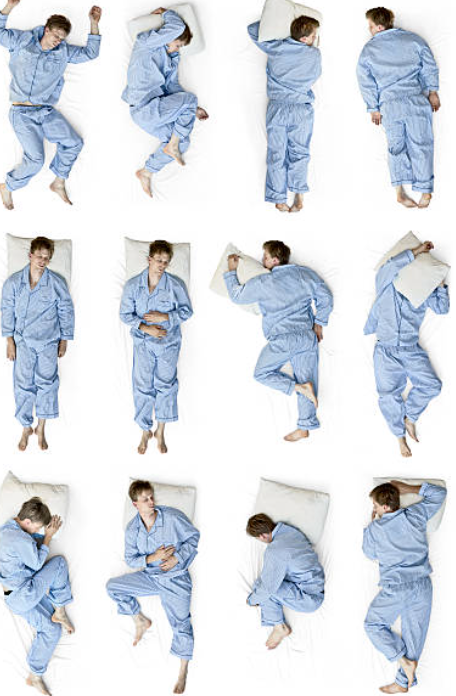Types of sleep positions - what sleep position is popular?
·

·
Greetings, fellow sleep enthusiasts! Today, we embark on a journey through the enigmatic realm of sleep positions, an integral but often underestimated aspect of our nightly sleep routines. As we delve into the science behind different sleep postures, we'll uncover the most popular positions and unravel the mysteries of why they matter for a comfortable and restful slumber. So, let's venture forth into the realm of sleep positions and uncover the rationale behind their popularity.
Side Sleeping: The Grandeur of Alignment
1. **The Fetal Position**: Ah, the fetal position, a timeless classic favored by many. Curled up like a cozy cocoon, it mirrors the comfort of the womb. This position encourages spinal alignment, reduces snoring, and eases sleep apnea symptoms, rendering it a popular choice for those seeking a serene night's sleep.
2. **The Log Position**: A distant cousin to the fetal pose, the log position presents an extended and straightened approach. It's a sleek, elongated posture that promotes spinal alignment while accommodating those who prefer the side sleeping embrace.
Back Sleeping: The Throne of Support
1. **The Supine Position**: Back sleeping is often likened to the royal throne of sleep positions, offering regal spinal support. With your spine aligned in its natural curvature, the supine position reduces the risk of neck and back pain, creating a canvas of comfort for a restorative slumber.
Stomach Sleeping: The Unconventional Trendsetter
1. **The Prone Position**: Stomach sleeping may seem like an unconventional choice, but for some, it's a preferred trendsetter. While it can assist with snoring and sleep apnea, it's essential to tread carefully, as it may strain the neck and lower back, potentially compromising overall sleep comfort.
The Quest for Sleep Comfort
1. **Individual Preference**: Just as our personalities differ, so do our sleep preferences. The popularity of specific sleep positions often stems from personal comfort and past experiences.
2. **Health Considerations**: Certain sleep positions offer unique health benefits. For instance, side sleeping is often recommended for pregnant individuals to enhance circulation to the fetus and reduce pressure on major blood vessels.
3. **Sleep Disorder Management**: People with sleep disorders like sleep apnea often gravitate toward positions that alleviate symptoms. For instance, side sleeping can be advantageous in minimizing sleep apnea-related snoring and breathing interruptions.
In the marvelous world of sleep positions, each posture unveils a story of comfort, health, and personal preference. From the regal embrace of back sleeping to the nurturing cocoon of side sleeping, and even the audacious trendsetting of stomach sleeping – each position has its allure. By understanding the science behind these positions, we empower ourselves to choose the one that resonates with our individual needs, leading us toward a peaceful slumber.
Side Sleeping: The Grandeur of Alignment
1. **The Fetal Position**: Ah, the fetal position, a timeless classic favored by many. Curled up like a cozy cocoon, it mirrors the comfort of the womb. This position encourages spinal alignment, reduces snoring, and eases sleep apnea symptoms, rendering it a popular choice for those seeking a serene night's sleep.
2. **The Log Position**: A distant cousin to the fetal pose, the log position presents an extended and straightened approach. It's a sleek, elongated posture that promotes spinal alignment while accommodating those who prefer the side sleeping embrace.
Back Sleeping: The Throne of Support
1. **The Supine Position**: Back sleeping is often likened to the royal throne of sleep positions, offering regal spinal support. With your spine aligned in its natural curvature, the supine position reduces the risk of neck and back pain, creating a canvas of comfort for a restorative slumber.
Stomach Sleeping: The Unconventional Trendsetter
1. **The Prone Position**: Stomach sleeping may seem like an unconventional choice, but for some, it's a preferred trendsetter. While it can assist with snoring and sleep apnea, it's essential to tread carefully, as it may strain the neck and lower back, potentially compromising overall sleep comfort.
The Quest for Sleep Comfort
1. **Individual Preference**: Just as our personalities differ, so do our sleep preferences. The popularity of specific sleep positions often stems from personal comfort and past experiences.
2. **Health Considerations**: Certain sleep positions offer unique health benefits. For instance, side sleeping is often recommended for pregnant individuals to enhance circulation to the fetus and reduce pressure on major blood vessels.
3. **Sleep Disorder Management**: People with sleep disorders like sleep apnea often gravitate toward positions that alleviate symptoms. For instance, side sleeping can be advantageous in minimizing sleep apnea-related snoring and breathing interruptions.
In the marvelous world of sleep positions, each posture unveils a story of comfort, health, and personal preference. From the regal embrace of back sleeping to the nurturing cocoon of side sleeping, and even the audacious trendsetting of stomach sleeping – each position has its allure. By understanding the science behind these positions, we empower ourselves to choose the one that resonates with our individual needs, leading us toward a peaceful slumber.



